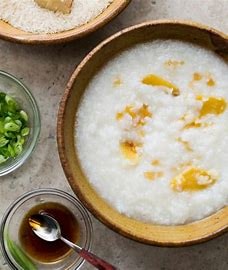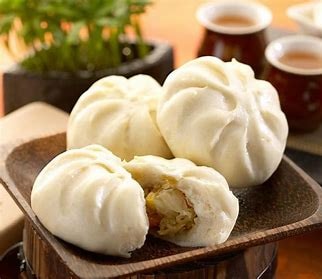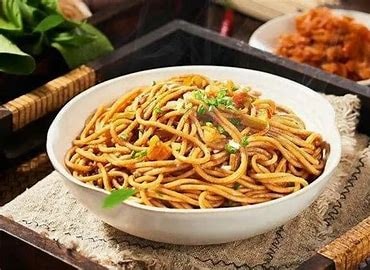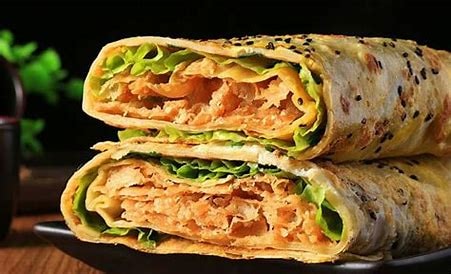Healthy Chinese Breakfast Foods
Chinese breakfast culture is a vibrant tapestry of flavors, textures, and regional specialties, reflecting the country’s culinary diversity and emphasis on balanced nutrition. Across China, there is a wide variety of breakfast options that showcase the unique tastes and traditions of different regions. In this article, Wukong Education will introduce to you the traditional Chinese breakfast.
Popular breakfast foods include congee, steamed buns, fried dough sticks, and noodles, which are enjoyed throughout the country. Chinese people eat a diverse range of foods for breakfast, from savory porridges to sweet pastries, depending on local preferences and traditions.

Congee and Crullers: A Classic Duo
Congee (粥), a comforting bowl of rice porridge simmered to creamy perfection, is a staple across China. Made by slow-cooking rice in water or broth, it is typically served in a bowl and acts as a blank canvas for delicious toppings like pickled vegetables, preserved eggs, minced pork, or seafood.
Learn authentic Chinese from those who live and breathe the culture.
Specially tailored for kids aged 3-18 around the world!
Get started free!In northern China, congee is often paired with savory additions such as fermented tofu or shredded chicken, while southern regions might drizzle it with ginger-infused brown sugar syrup for a sweet twist. Congee and crullers are classic dishes that many people eat for breakfast across the country.

The quintessential companion to congee is youtiao (油条), deep-fried dough sticks prized for their crispy exterior and airy interior. These golden crullers are commonly dipped into soy milk (豆浆) or torn into pieces and mixed into congee for added texture. Street vendors and small restaurants alike serve this duo, making it a convenient yet hearty option for commuters.

Steamed Buns and Dumplings: Pillars of Morning Meals
Steamed buns (包子), also known as stuffed buns, are a cornerstone of Chinese breakfasts, enjoyed from bustling cities to rural villages. These fluffy, yeast-leavened buns come in endless varieties with various fillings, including both savory and sweet fillings:
- Savory options: Stuffed with meat such as minced pork, ham, shrimp, or vegetables like chives and cabbage, as well as other ingredients. Sesame seeds are often sprinkled on top for extra flavor.
- Sweet versions: Filled with sweet fillings such as red bean paste, black sesame paste, or custard.

In Shanghai, soup dumplings (汤包) take center stage, with delicate wrappers encasing hot broth and pork fillings. These tasty buns and dumplings are commonly eaten for breakfast, but are also enjoyed as a snack, for snacking, or as a convenient meal for lunch or dinner.

Dumplings (饺子 and 馄饨) also grace breakfast tables. Steamed dumplings are a popular breakfast item, and these foods are often eaten as a snack or for snacking throughout the day. Northern China favors boiled or pan-fried pork dumplings, while southern regions like Guangdong incorporate dim sum into morning tea rituals. Dim sum features a variety of tasty bite-sized delights—steamed shrimp dumplings, pancakes, or rice noodle rolls—often served with soy sauce and chili oil.

Hot-Dry Noodles: A Wuhan Specialty

Originating in Wuhan, hot-dry noodles (热干面) are a popular breakfast and commonly eaten dish, especially in Wuhan, characterized by chewy wheat noodles tossed in sesame paste, chili oil, and pickled radish. This delicious and tasty specialty is not only a breakfast favorite but is also enjoyed for lunch and dinner, making it a versatile meal option.
The noodles are pre-cooked, dried, and quickly scalded before serving, ensuring a springy texture. Locals often enjoy this spicy, umami-rich dish with a side of soy milk or tea eggs, and it can be topped with other ingredients such as chopped scallions, garlic, or pickled vegetables to enhance its flavor. Its popularity has spread beyond Hubei, becoming a symbol of regional pride and a must-try street food commonly eaten by locals and visitors alike.
Breakfast Crepe: The Versatile Jian Bing
The jian bing (煎饼), a savory crepe hailing from northern China, is similar to other Asian pancakes and stands out as one of many delicious breakfast options available in China. A thin batter of wheat and mung bean flour is spread on a griddle, topped with an egg, scallions, cilantro, and a crispy fried wonton skin, and sometimes garnished with sesame seeds. It’s then folded around a youtiao or brushed with hoisin sauce and chili paste. This tasty and popular snack is often eaten on the go, catering to busy urbanites with its customizable and delicious various fillings—such as ham, vegetables, and other ingredients—making it a versatile choice for breakfast or a quick bite.

Regional and Cultural Nuances
- Many Asians enjoy similar breakfast foods that reflect their regional and cultural traditions.
- Northern China: Wheat-based dishes dominate, such as steamed buns and hand-pulled noodles. Traditional breakfast pairings often include soybean milk.
- Southern China: Rice-centric meals prevail, including rice noodles, fried rice, and zongzi (glutinous rice wrapped in bamboo leaves).
- Street Food Culture: From tofu pudding (豆花) drizzled with syrup in the south to sesame-topped flatbreads in the north, street stalls and vendors play a vital role in daily breakfast routines, offering quick and authentic options.
Modern Adaptations
While traditional foods remain popular, globalization has introduced Western elements like coffee and toast, highlighting the contrast between Chinese breakfast and a typical Western breakfast of eggs, bread, and bacon. However, the essence of Chinese breakfast—balance, convenience, and flavor diversity—continues to thrive, bridging generations and regions.
FAQ About Chinese Breakfast
What do Chinese Eat for Breakfast, Lunch and Dinner?
Chinese breakfast often includes porridge, soy milk and fried dough sticks. For lunch and dinner, people commonly have rice or noodles with stir-fried vegetables, tofu and meat. Dumplings and wontons are also popular. The diet varies by region.
What’s the Typical Chinese Breakfast?
A typical Chinese breakfast often consists of porridge, soy milk and fried dough sticks. Steamed buns and savory crepes are also common. It varies by region but these are the most typical options.
How Many Meals do Chinese Eat a Day?
Chinese typically eat three meals a day: breakfast, lunch and dinner. Some may also have snacks between meals, but the standard is three main meals.
Conclusion
Chinese breakfast is diverse and full of local flavors. People often eat porridge, which is easy to digest and suitable for the morning. Soy milk and fried dough sticks are a classic combination, with crispy and soft textures. Steamed buns and Mantou are also common because they are convenient and delicious. In some regions, people prefer rice noodle rolls or Wonton noodles. Chinese breakfast emphasizes balance and simplicity, providing energy for the day ahead.
If you want to know more about Chinese culture, you can click the link below, WuKong Chinese [Online Classes] will continue to accompany you in your Chinese learning.
Learn authentic Chinese from those who live and breathe the culture.
Specially tailored for kids aged 3-18 around the world!
Get started free!
Master’s degree from Yangzhou University. Possessing 10 years of experience in K-12 Chinese language teaching and research, with over 10 published papers in teh field of language and literature. Currently responsible for teh research and production of “WuKong Chinese” major courses, particularly focusing on teh course’s interest, expansiveness, and its impact on students’ thinking development. She also dedicated to helping children acquire a stronger foundation in Chinese language learning, including Chinese characters, phonetics (pinyin), vocabulary, idioms, classic stories, and Chinese culture. Our Chinese language courses for academic advancement aim to provide children with a wealth of noledge and a deeper understanding of Chinese language skills.






![The Real Story of Monkey King, Sun Wukong [Chinese Mythology] The Real Story of Monkey King, Sun Wukong [Chinese Mythology]](https://wp-more.wukongedu.net/blog/wp-content/uploads/2025/01/Havoc-In-Heaven-520x293.jpg)












![Inspiring Quotes About Education for Kids [2025 Updated List] Inspiring Quotes About Education for Kids [2025 Updated List]](https://wp-more.wukongedu.net/blog/wp-content/uploads/2025/10/生成特定封面图-520x293.png)







Comments0
Comments